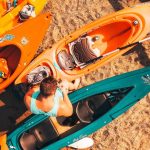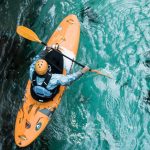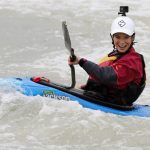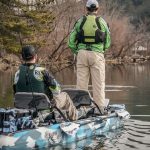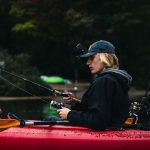In this article, we’ve got all the information you need to decide on the optimal kayak size. Discuss kayak sizes like a pro!

What a world we live in!
We live in a world where a fork and spoon can be combined to create a truly epic and versatile spork, where two of my all-time favorite foods are mixed to produce Buffalo Wing Lasagna (yes, it’s a real thing!), and where the music of Nine Inch Nails and Taylor Swift can be blended together to make a song that is both spectacular and chilling.
But no mash-up is quite as epic as blending two iconic pieces of watersports gear: the paddleboard and kayak.
Yes, you read that right: a stand-up paddleboard (SUP) and a kayak in one!
Paddleboard kayak hybrids bring the best of both worlds into your life, giving you everything you love about both paddleboards and kayaks in one ultra-versatile (and badass) piece of equipment.
Never heard of these mash-ups? Don’t worry!
In this post, I’m going to walk you through everything you need to know about SUP kayak combos: what the heck they are, the pros/cons, the factors to consider, and how to choose the right one.
Plus, I’ll give you a list of the best paddleboard kayak hybrids around so you can choose the one that suits your needs best—just in time for your next summer outing.
Get ready to take your paddling to the next level with these spectacular hybrids.
As an affiliate of Amazon and other retailers, we may earn a small commission when you buy via our links, at no additional cost to you. Thank you!
Quick Answer: The Best Paddleboard Kayak Hybrids for You
- Best Overall: Bestway Hydro-Force Oceana Inflatable Stand Up Paddle Board
- Most Versatile: Bluefin Cruise SUP Package
- Best Hardshell: Perception Hi Life 11 Kayak
- Best for Beginners: Ocean Kayak Nalu 11
- Most Stable: BOTE Deus Aero Inflatable Kayak
- Best Premium: LONO Aero 12′6″ Verge Camo Inflatable Kayak
- Best Lightweight: FunWater SUP Inflatable Stand Up Paddle Board
- Best for Fishing: Vibe Cubera 120
- Best for Heavy and Tall Paddlers: Sea Eagle FishSUP 126
- Best-Looking: Crescent Kayaks Stand Up Paddleboard Plus
Comparison table: Best Paddleboard Kayak Hybrids
| Model | Specs | Where To Buy |
Bestway Hydro-Force Oceana Inflatable Stand Up Paddle Board | Hybrid Style: Paddleboard Plus Shell: Inflatable Weight: 30 lbs Length: 10 ft | Amazon |
Bluefin Cruise SUP Package | Hybrid Style: Paddleboard Plus Shell: Inflatable Weight: 38.7 lbs Length: 10’8” | Amazon |
Perception Hi Life 11 Kayak | Hybrid Style: Paddleboard Plus Shell: Hardshell Weight: 55 lbs Length: 11 ft | Eco Fishing Shop |
 Ocean Kayak Nalu 11 | Hybrid Style: Paddleboard Plus Shell: Hardshell Weight: 44 lbs Length: 11 ft | Amazon |
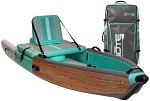 BOTE Deus Aero Inflatable Kayak | Hybrid Style: Paddleboard-Style Kayak Shell: Inflatable Weight: 41 lbs Length: 11 ft | Amazon |
 LONO Aero 12′6″ Verge Camo Inflatable Kayak | Hybrid Style: Paddleboard-Style Kayak Shell: Inflatable Weight: 73 lbs (including accessories) Length: 12’6” | Amazon |
 FunWater SUP Inflatable Stand Up Paddle Board | Hybrid Style: Paddleboard Plus Shell: Inflatable Weight: 17 lbs Length: 10 ft | Amazon |
Vibe Cubera 120 | Hybrid Style: Paddleboard Plus Shell: Hardshell Weight: 72 lbs (32.66 kg) Length: 12 ft | Ekectric Surf Sports |
 Sea Eagle FishSUP 126 | Hybrid Style: Paddleboard Plus Shell: Inflatable Weight: 45 lbs (20.41 kg) Length: 12’6” | Amazon |
Crescent Kayaks Stand Up Paddleboard Plus | Hybrid Style: Paddleboard Plus Shell: Hardshell Weight: 58 lbs (26.3 kg) Length: 11’10” | Crescent |
Best Paddleboard Kayak Hybrids
Best Overall: Bestway Hydro-Force Oceana Inflatable Stand Up Paddle Board
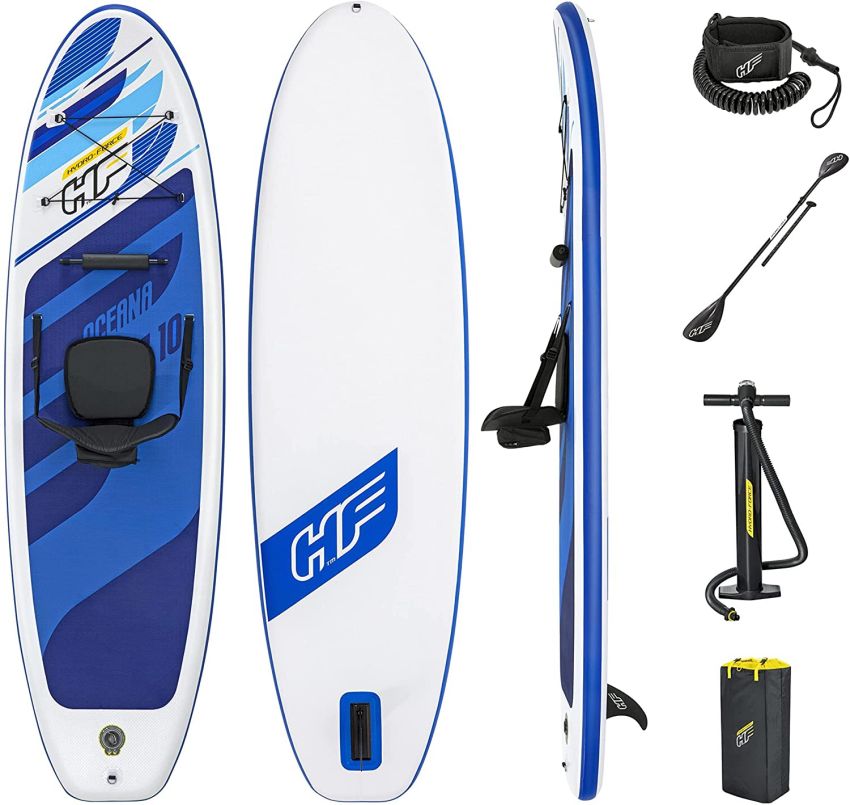
Hybrid Style: Paddleboard Plus
Shell: Inflatable
Weight: 30 lbs (13.6 kg)
Length: 10 ft (304.8 cm)
This is just what you need to take your paddleboarding adventures to the next level! Not only is it easily convertible to a kayak (installing the provided seat), but its inflatable design means you can take it anywhere you go, carrying it in the handy provided backpack.
With a weight capacity of 265 pounds, it’s sized for larger-than-average paddlers. The backrest and footrest are both detachable, as is the center fin. There is only limited storage, but for the price, you won’t find many better options!
Pros:
- Affordable but still excellent quality
- Durable material, won’t break or pop
- Good weight capacity
- Lightweight, easily portable
Cons:
- One-way valve for pumping prone to leaks
Most Versatile: Bluefin Cruise SUP Package
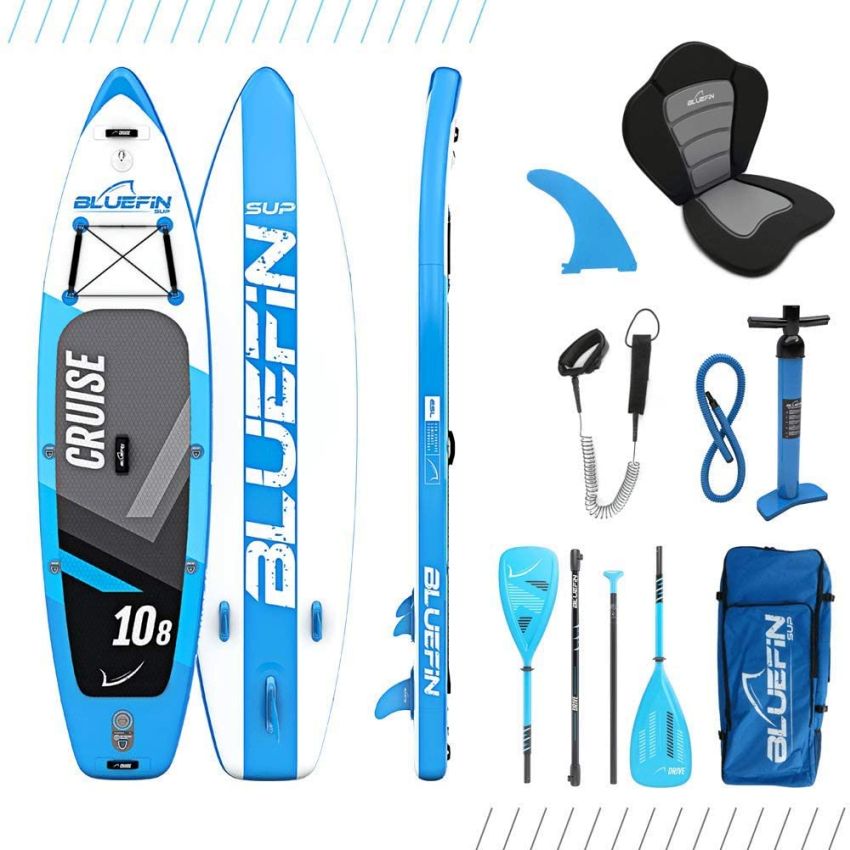
Hybrid Style: Paddleboard Plus
Shell: Inflatable
Weight: 38.7 lbs (17.6 kg)
Length: 10’8” (325.12 cm)
This paddleboard doesn’t have the highest weight capacity (just 220 lbs), so it’s not suitable for extra-tall, extra-heavy paddlers. However, for the “average” person, it’s an absolute dream thanks to the many, many D-rings integrated into its deck.
Not only do you get four D-rings located right in the center of the board, but there’s an extra one at the back so you can clip on additional storage options or even mount an action camera. The kit includes a convertible paddle for both kayaking and paddleboarding, a comfortable seat, and a carrying bag, double-action pump, and fin. The combination of 1000D nylon and PVC makes it a truly durable hybrid.
Pros:
- Sturdy and tough
- Can mount an action camera, plenty of D-rings for any seat design
- Very stable paddleboard
- Ultra-light convertible paddle
Cons:
- Low weight capacity
Best Hardshell: Perception Hi Life 11 Kayak

Hybrid Style: Paddleboard Plus
Shell: Hardshell
Weight: 55 lbs (24.95 kg)
Length: 11 ft (335.28 cm)
If you want a paddleboard kayak hybrid built for adventure, give this one a try! Not only it is made with a super sturdy polyethylene hull, but the deck is even cushioned to keep your feet comfortable and add extra traction when the board is wet. Thanks to its 11-foot length and 280-pound weight capacity, it’s great for larger, heavier paddlers who dare to brave rough, choppy waters.
The seat is fully adjustable and offers good back support, and the hybrid includes fishing mounts (optional) that are perfect for angling on the water. You’ll love the low profile swim deck that lets you jump in the water then climb back aboard with ease. As long as you don’t mind the extra weight and a high price tag, it’s just what you’re looking for.
Pros:
- Swim deck makes it easy to get back on board from the water
- Ultra-durable, sturdy, and stable
- Good back support, adjustable seat design
- Can feature fishing mounts, flexible hardware
Cons:
- Heavy, as expected of hardshell kayaks/paddleboards
Best for Beginners: Ocean Kayak Nalu 11
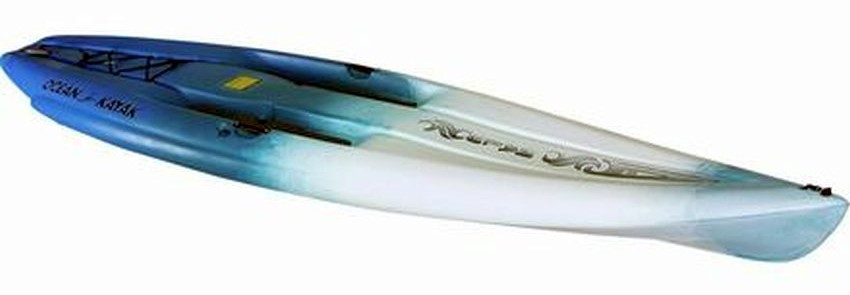
Hybrid Style: Paddleboard Plus
Shell: Hardshell
Weight: 44 lbs (19.96 kg)
Length: 11 ft (335.28 cm)
If you’re new to the paddleboard, you’ll find this is one of the most forgiving, stable options on the market. At just 11 feet long and weighing 44 pounds, it will keep you steady on the water even if the wind kicks up or you’re losing your balance. With a 275-pound weight capacity, it’s rated for heavier and taller paddlers, too.
The polyethylene shell can handle all sorts of bumps and knocks without any damage, and its shape and molded-in fins increase maneuverability to make for easier handling and tracking. Thanks to the built-in drain holes, the water will slide right off, leaving you sitting high and dry.
Pros:
- Padded foot wells offer good traction when wet
- Comfortable, well-padded seat
- Molded-in fins improve tracking/handling
- Ultra-tough
Cons:
- Heavy
Most Stable: BOTE Deus Aero Inflatable Kayak
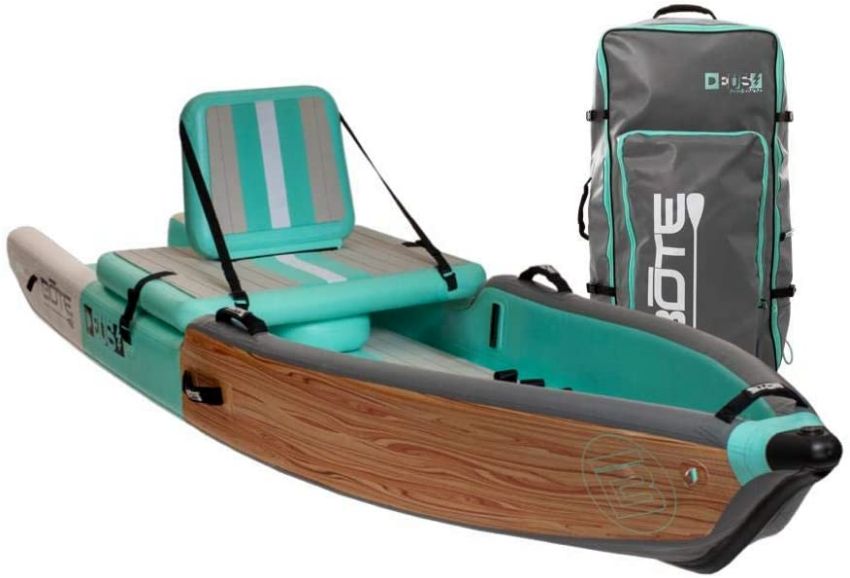
Hybrid Style: Paddleboard-Style Kayak
Shell: Inflatable
Weight: 41 lbs (18.6 kg)
Length: 11 ft (335.28 cm)
This is the first of its kind, and one of the few paddleboard-style kayaks on the market. Thanks to its high sidewalls and self-draining cockpit, you can keep your deck dry. Best of all, it’s an inflatable option that will transition between your vehicle and the water in a matter of minutes.
It may be a bit heavier than you’d expect for an inflatable kayak, and users aren’t thrilled by the fact that they have to buy the paddle separately. However, in terms of comfort, versatility, and stability, you’ll find few better. Even beginners love how beautifully steady the paddleboard kayak hybrid is even on rough water.
Pros:
- Peerless stability (mostly primary, but some secondary)
- Portable and easy to transport, but still ultra-versatile
- Sit-on-top kayak with draining cockpit and padded foot wells
- Top can be used as a float for your cooler/gear
Cons:
- Tracking/handling isn’t the best
Best Premium: LONO Aero 12′6″ Verge Camo Inflatable Kayak
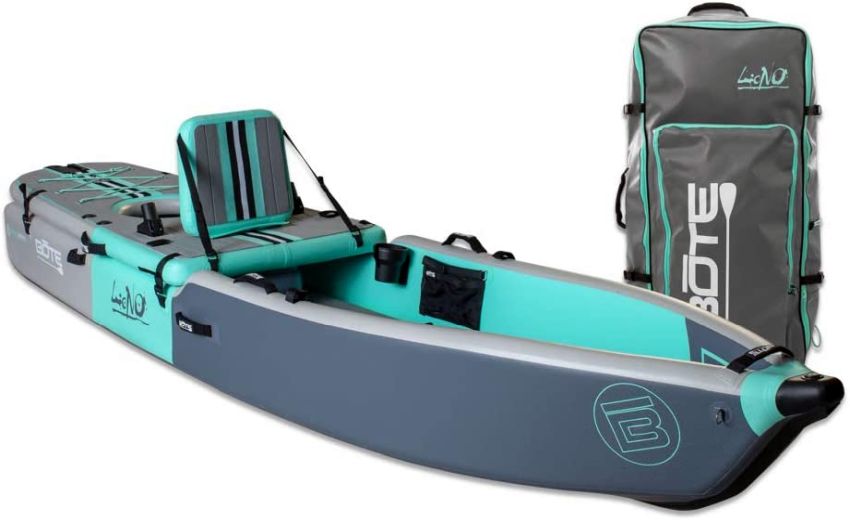
Hybrid Style: Paddleboard-Style Kayak
Shell: Inflatable
Weight: 73 lbs (including accessories) (33.11 kg)
Length: 12’6” (381 cm)
If you want only the best and don’t mind paying a higher price tag, this is the paddleboard kayak hybrid for you. Its inflatable design makes it ultra-portable, but it’s built for maximum versatility, too, with the option to incorporate the Apex Pedal Drive for foot-powered propulsion. Anglers will love that they can keep their hands free to cast and reel in all day long.
It’s incredibly stable, perfect for fishing standing up or sitting down, and is compatible with Rocket Racs to mount your fishing poles and Magnepod magnetic mounts to keep your drinks always safely anchored to the deck. Boteboard’s Aero Technology keeps it rigid even when under-inflated, and gives you the best possible performance for long as you’re out on the water.
Pros:
- Great for anglers, thanks to multiple rod/drink mounting options
- Stable and steady even in rough water
- Pedal drive-compatible
- Lightweight, very portable
Cons:
- VERY pricey—about the same price tag as a top-end kayak
Best Lightweight: FunWater SUP Inflatable Stand Up Paddle Board
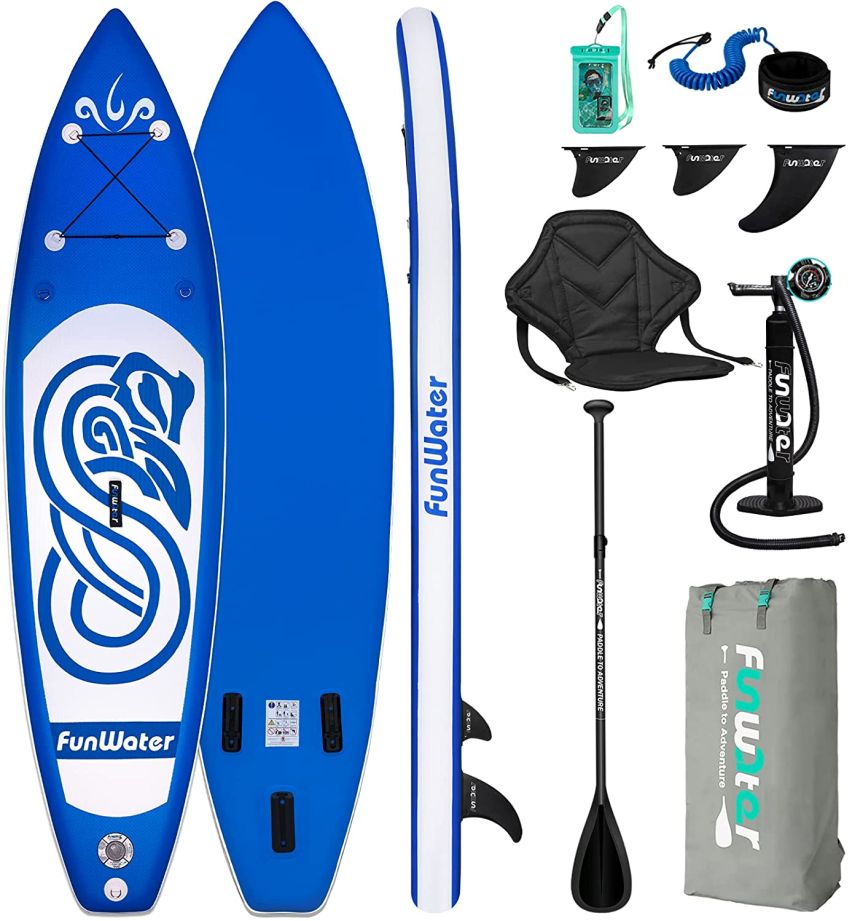
Hybrid Style: Paddleboard Plus
Shell: Inflatable
Weight: 17 lbs (7.71 kg)
Length: 10 ft (304.8 cm)
Don’t want to be bothered lugging around a ton of gear? You’ll never have to with this paddleboard! Despite being 10 feet long, it weighs just 17 pounds (plus the accessories in the backpack bag), so literally anyone can haul it to/from the water.
The military-grade double wall PVC is sturdy despite weighing very little, and will withstand many years of direct sunlight and adventure paddling. The placement of the seat (at the front) is a bit odd, and some users found it was a bit hard to paddle. However, with a weight capacity of 300 pounds, it’s compatible with just about anyone.
Best of all, it’s not only the lightest of the paddleboard kayak hybrids, but also the most budget-friendly. Its retail price is at least 20-40% lower than the next-best-priced model on our list!
Pros:
- Lightest and most affordable paddleboard kayak hybrid on the market
- Durable and sturdy material
- Easily inflate/deflate in a matter of minutes
- Good weight capacity
Cons:
- Seat placement is odd
Best for Fishing: Vibe Cubera 120

Hybrid Style: Paddleboard Plus
Shell: Hardshell
Weight: 72 lbs (32.66 kg)
Length: 12 ft (365.76 cm)
Anglers, take note: this is the paddleboard kayak hybrid you’ll want to take out on your next fishing trip! At 12 feet long, it’s sturdy and stable enough that you’ll never lose your balance, no matter how hard you cast or how much you have to struggle to reel in that stubborn fish. Thanks to the 475-pound weight capacity, you can always keep piling on another tackle box, bait box, or cooler without worrying about rocking the boat (or kayak).
The rotomolded high density polyethylene shell is filled with a sink-proof pressure-injected foam, which, while excellent for stability, means the hybrid is definitely on the heavy side. You also have to buy the seat separately, though it’s compatible with the same hyper-comfortable Summit Seat as the Vibe Shearwater. Once aboard and out on the water, you’ll never want your fishing trip to end!
Pros:
- Unsinkable, ultra-stable
- Excellent weight capacity, good on-deck storage space
- Comfortable seat (sold separately)
- Great for heavy paddlers
Cons:
- VERY heavy
- Seat has to be purchased separately
Best for Heavy and Tall Paddlers: Sea Eagle FishSUP 126
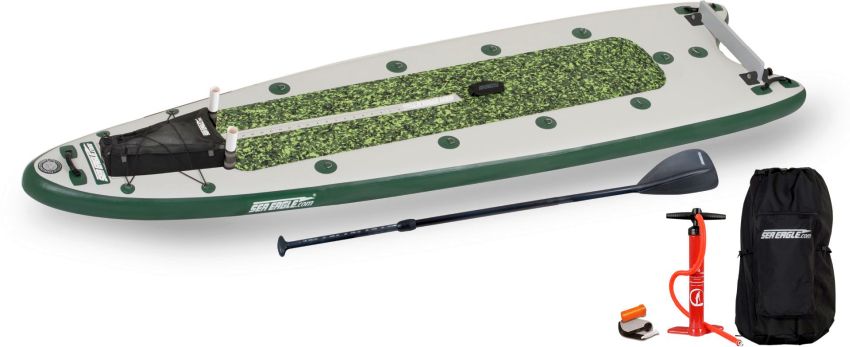
Hybrid Style: Paddleboard Plus
Shell: Inflatable
Weight: 45 lbs (20.41 kg)
Length: 12’6” (381 cm)
If you’re a big, tall guy (like me), you’ll instantly fall in love with this paddleboard kayak hybrid. Though it’s a bit on the heavier side for an inflatable, it’s incredibly stable even on rough waters and has a weight capacity of 500 pounds, significantly more than nearly every other hybrid on the market.
The 1000D nylon is reinforced with quadruple-overlapped drop stitch seams, and you’ll find it can take a serious beating and still emerge unscathed. It comes with a swivel seat (included) and a mount for a trolling motor, along with 14 stainless steel D-rings and the option to mount all sorts of awesome fishing mounts and hardware. Thanks to its 40-inch width, 12 ½ foot length, and non-slip EVA foam footbed, you can paddle and fish trusting you’ll always have a steady, grippy platform to stand on all day long.
Pros:
- Industry-leading weight capacity
- Ultra-wide, very long, incredibly stable
- Swivel seat included
- Can accommodate trolling motor (up to 55 lbs of thrust) and rod holders
Cons:
- Heavier-than-expected for an inflatable kayak
Best-Looking: Crescent Kayaks Stand Up Paddleboard Plus
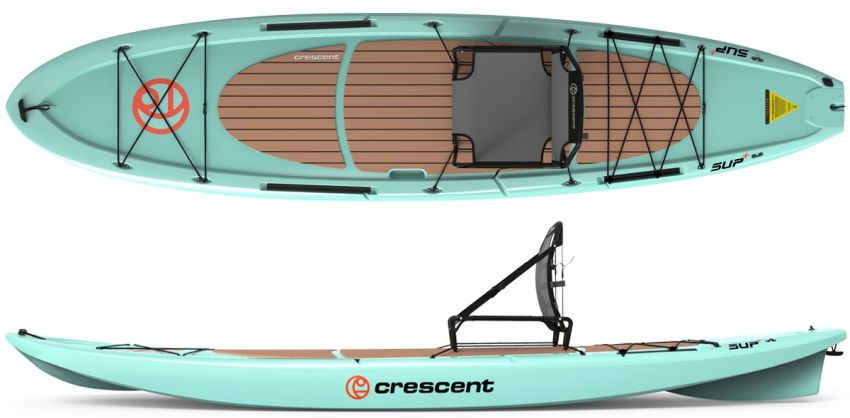
Technical Specs:
Hybrid Style: Paddleboard Plus
Shell: Hardshell
Weight: 58 lbs (26.3 kg)
Length: 11’10” (360.68 cm)
You’ve never seen a paddleboard kayak hybrid quite as sleek and beautiful as this one! It’s all clean lines and bright colors, but it never sacrifices function in the name of form. Other than its moderate weight capacity, it’s as good a SUP as you could ask for.
Epic features include a catamaran-style cathedral hull, an oversized molded-in skeg, two adjustable bungee systems for extra gear storage, a self-bailing deck, removable seat, and compatibility with YakAttack mounts. Though the price is high, it’s well worth every penny for such a gorgeous, ultra-reliable paddleboard kayak hybrid!
Pros:
- Good storage space, roomy deck
- Catamaran-style deck is extremely stable
- Compatible with YakAttack mounts, Power Pole, or trolling motor
- Long-lasting and hyper-durable
Cons:
- Heavy
- Pricey
A Complete Guide to Paddleboard Kayak Hybrids
What is a Paddleboard Kayak Hybrid?
When I first heard about paddleboard kayak hybrids, the first thing I said was “WHAT?”
Probably your initial reaction, too.
Curiosity soon won out over my surprise, so I set out to investigate what the heck these cool-sounding hybrids were. I learned that there are actually two types of paddleboard kayak hybrids:
- A “Paddleboard Plus” – Basically, this form of hybrid starts off with a (mostly) standard paddleboard that features a lot of D-rings set into the deck. These D-rings serve as mounting hardware for a kayak-style seat. Once the seat is strapped in place, you sit on it like a kayak and get to paddling!
- A Paddleboard-Style Kayak – This type of hybrid (like the LONO Aero 12′6″ Verge Camo Inflatable Kayak, for example) is designed like an open-top kayak, complete with a hard shallow-draft hull, sidewalls (lower than a regular kayak’s), seat, and even built-in storage. However, they are wider and longer than your average kayak, with the high primary stability of a paddleboard. They’re also designed for you to stand up in them and paddle them like a paddleboard.
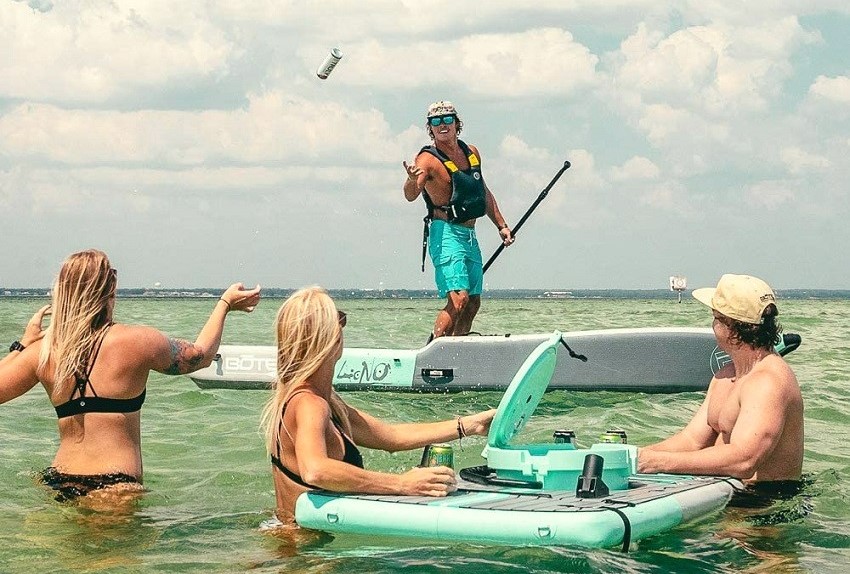
Can any Stand Up Paddleboard be used as a “hybrid”?
This was the second question I asked after I figured out what the paddleboard kayak hybrid was. After all, it would be awesome to just buy a paddleboard on the cheap, strap on a seat, and get to paddling!
Well, it’s not exactly that simple…
You see, the majority of paddleboards (especially budget models) don’t really include enough D-rings. They’ll have maybe 1 (to secure the leash/tether) or 2, but not enough (in the right places) to secure a kayak-style seat.
There are some standard paddleboards that do feature enough D-rings to be turned into a paddleboard kayak hybrid (many of them on our list below). However, not any paddleboard can be turned into a hybrid.
Benefits of a Paddleboard Kayak Hybrid
What makes a paddleboard kayak hybrid such a great choice compared to either a paddleboard or kayak on their own?
● Way more versatile. It’s double the fun, all with the same piece of equipment!
● Safe and easy setup. All you have to do is mount the seat on your paddleboard, and you’re ready to go in a matter of minutes.
● More comfortable for long trips. Because there’s a seat included, you have the option to stand, lie down, and sit. Better back support means longer paddling times without fatigue!
● Better stability on choppy water. The hardshell paddleboard-style hybrids have the shallow-draft hull and sidewalls that not only keep water from spilling over the sides, but also help to offer better stability when the water kicks up.
● Takes up less space. You only have to hang one piece of equipment on your garage wall rather than trying to figure out where to store both a kayak and paddleboard.
● Inexpensive. You’ll pay more for a “paddleboard plus” style hybrid (with extra D-rings) than you’d pay for a budget model, but far less than a premium kayak.
All pretty great reasons to consider the hybrid, right?
Drawbacks of a Paddleboard Kayak Combo
As with any piece of water sports equipment, the paddleboard kayak hybrid isn’t perfect. A few of the drawbacks include:
- Attachments may be weak/insufficient. A seat installed on a paddleboard will offer less back support than a kayak’s built-in seat. The straps/components are also more prone to breaking.
- Minimal gear storage. If you’re using the “paddleboard plus” style, the only gear storage will be the bungee cords secured to the front of the board. That’s enough for a dry bag and not much else!
- No water protection. Paddleboards are designed for warm-weather use because there’s nothing protecting you from the water.
Though it’s not a perfect piece of equipment, it’s still a whole lot of fun to use!
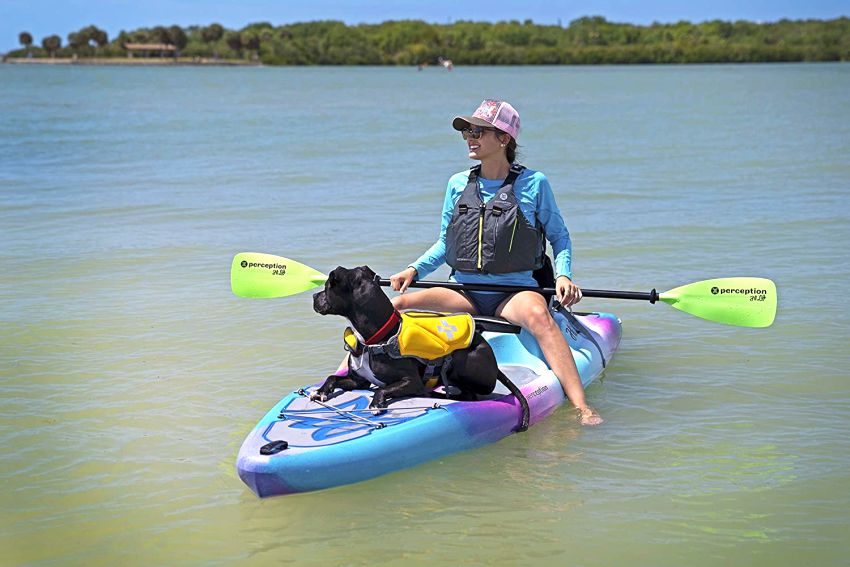
Factors to Consider When Buying a SUP Kayak Crossover
If you’re thinking about buying one of these paddleboard kayak hybrids, good for you! You’ve got a whole new sort of water adventure awaiting you.
But take a moment to consider carefully the factors below—they’ll help you make the right decision and choose the paddleboard kayak hybrid that suits your needs best.
Experience Level
I’m an experienced kayaker (with years of paddling under my belt), but you should see me on a paddleboard! I’m lucky to stay upright when the water gets choppy, and I spend nearly as much time in the water as on the board. (I’m still learning!)
On the other hand, a few of my friends are badasses on the paddleboard, zipping around the lake or beach. However, put them in a kayak, and they’re pretty much useless.
The truth is that both paddleboarding and kayaking involve paddling, the skills don’t necessarily transfer between the two. The paddling form is totally different when you’re sitting in an enclosed-hull kayak and standing on what is essentially a floating plank.
Paddleboarders will have to work harder on their seated paddling skills, while kayakers will have to work on staying balanced in the upright position.
Those with experience in both types of water equipment will usually find the transition fairly seamless, though.
Paddling Destination
Let’s be real: paddleboards aren’t exactly suited for all water conditions.
Sure, they’re amazing when paddling on a flat lake or the ocean when the surf is low, but they’re definitely not the right choice for adventure/expedition touring or whitewater rafting.
You’ll find that paddleboards are typically more than stable enough for fishing/angling, but you don’t want to do hunting from atop a paddleboard.
Keep in mind your destination (and activity) to inform your decision whether or not a paddleboard kayak hybrid is the right choice—or whether you should opt for a more traditional kayak instead.
Hardshell vs. Inflatable
There are a lot of paddleboard kayak hybrids that are inflatable, and some are the standard hardshell design. Both have their pros and cons, and while I won’t get into this (very heated) debate in full depth, I’ll share a quick list of why to consider each option:
Hardshell Kayak/SUP Hybrids:
Pros
- Sturdier, with a more solid hull and mounting hardware
- Lasts longer, more resistant to damage
- Requires far less maintenance and upkeep
- No need to inflate/deflate
Cons
- Typically more expensive
- Larger, bulkier, and require more space for transportation/storage
Inflatable Kayak/SUP Hybrids:
Pros
- Easily transportable, lightweight
- Doesn’t take up much space in your vehicle/garage/storage
- Typically more affordable
- May offer a higher weight capacity
Cons
- Require more maintenance
- More easily damaged
Pretty clear to see that both have their benefits and drawbacks. At the end of the day, it’s up to you to decide which suits your needs/lifestyle/capabilities best.
Durability
Whenever you’re shopping for water sports equipment, you always have to consider the durability of your kayak, paddleboard, or paddleboard kayak hybrid.
As you read in the previous section, hardshell paddleboard kayaks tend to be more durable than their inflatable counterparts. However, the inflatable options are getting tougher and studier with every passing year, so they’re a decent option to consider.
The really important factors for durability are:
- Sturdy material (be it PVC, nylon, or rotomolded polyethylene)
- Solidly welded seams that won’t rip or tear
- Integrated UV-protection that will protect your paddleboard kayak hybrid from damage by the sunlight
Read through not only the specs, but also the customer reviews to make sure the paddleboard kayak hybrid you’re considering has all of these factors!
Versatility
Both the “Paddleboard Plus” and “Paddleboard-Style Kayak” options are good to consider if you plan on doing more than just paddling on a lazy river or calm lake.
For the “Paddleboard Plus” type of hybrid, you want to make sure there are a lot of D-rings set into the deck (4 or more is excellent!). That way, you have options on where to place your seat, as well as anchor points to tether more gear storage solutions.
For the “Paddleboard-Style Kayak” hybrid, look for a design that is steady enough to handle both choppy and flat water. That way, you can take it out on the ocean, river, or lake and still be equally comfortable in any conditions.
Ease of Setup
When we talk about setup, really we mean converting the “Paddleboard Plus” hybrids from a simple paddleboard to a hybrid (with the seat).
Typically, the setup process should be fairly simple: all you have to do is clip the seat to the D-rings, tighten the straps to your preferred setting, and you’re ready to paddle.
However, it’s still worth considering the setup process as a factor when shopping. You can also opt for the “Paddleboard-Style Kayak” with the built-in seat—that way, you don’t have to worry about strapping/securing anything in place.
Weight Capacity
For the “average” paddler, this isn’t too much of a worry. They can hop on and off pretty much any paddleboard, and they’re good to go.
However, for people like me who are heavier than average, it’s a concern. There are many paddleboards that I’m just too heavy for (at 250 pounds), so I end up tipping/rocking/falling in because the paddleboard isn’t rated for my weight.
And that’s just my weight—we’re not even talking about adding on fishing gear, a drinks cooler, a backpack for overnight trips, camping gear, etc.
If you plan on just doing casual paddling, a lower weight capacity is more than enough. But you plan on doing any activity that involves extra gear, you may want to look for a higher-than-average weight capacity.
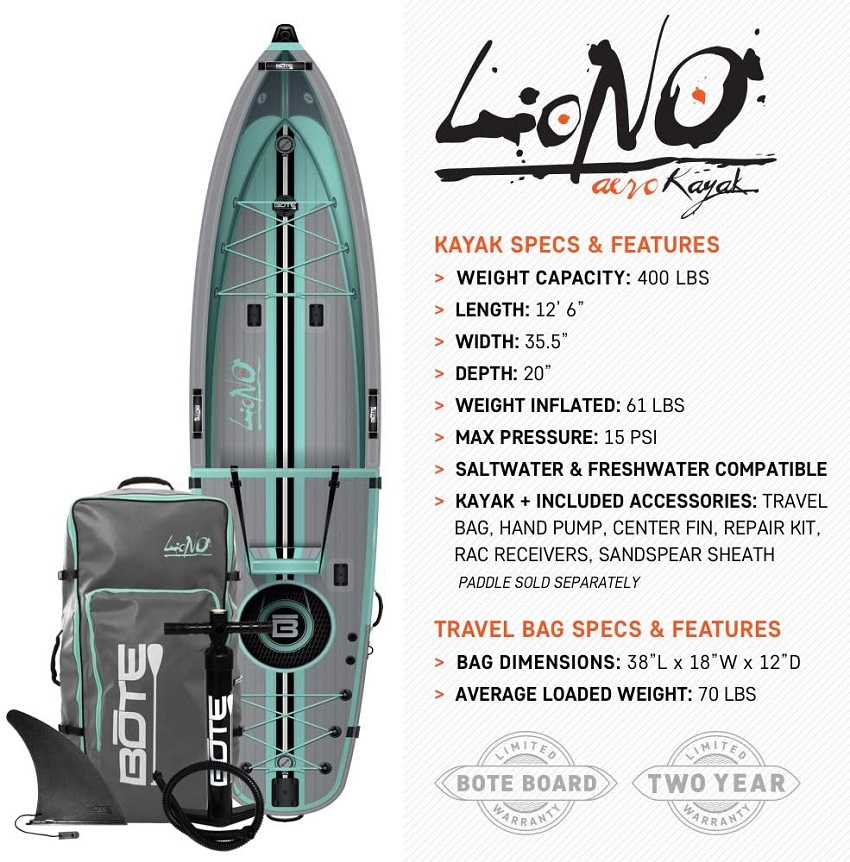
Paddler Height
Again, this is a problem that the majority of “average” paddlers won’t worry about, but extra-tall people like me (6’ 6”) will find a total pain in the rear.
Paddleboards (and paddleboard kayak hybrids) need to be a certain width in order to remain stable, and to provide a comfortable place to plant my feet as I paddle. If the board is too narrow, it will affect my balance because my feet will be too close together to take the proper balanced stance.
Also, if the board is too short, that can be a problem for taller users. If you’re above 6’ (and especially if you’re on the heavier side), you’ll want to find a longer, wider board.
Gear Storage
This may not be a big factor if you’re just going to paddle around a lake or the beach for a few hours. You might need to bring a dry bag (with your phone), a speaker for music, and a cooler bag with a few drinks. No big deal!
But if you’re going to take your paddleboard kayak hybrid fishing, camping, adventure paddling, or on an overnight/multi-day trip, you’re going to need someplace to store your gear.
Most paddleboards just include the bungee cord storage at the front—not really practical if you’ve got tackle boxes, backpacks, coolers, etc.
However, many “Paddleboard-Style Kayak” hybrids feature built-in storage compartments similar to kayaks, which allows you to store some gear. Or, if you’re going for the “Paddleboard Plus” style, you’ll have enough D-rings to clip your gear onto to secure it to your deck.
Portability
As the sucker who always ends up hauling my (VERY HEAVY) kayaks around, this is a factor I always consider with the utmost seriousness.
After all, the last thing I want is to burn through my energy loading the kayaks onto my car rack then hauling them to the water. And after a long day of paddling when my arms and core are tired, there’s no way I want to do it all again in reverse!
That’s one reason that I love the “Paddleboard Plus” style of hybrid. Many of them are inflatable (ergo, ultra lightweight) and fold down into a backpack that I can easily sling on my back (two at a time) and carry around with far less effort.
Paddle
Paddleboard paddles are not the same as kayak paddles (but you know this already!).
Paddleboards use a single-bladed paddle with a T-shaped handle at one end, whereas kayaks use a double-bladed paddle.
Paddleboard kayak hybrids typically use a paddle that can be converted between the two–exchanging the T-shaped handle for a second paddle blade. However, be aware that if the paddle breaks/bends/is damaged, it may be harder to replace than a standard paddleboard/kayak paddle.
Included Accessories
I love accessorizing!
Sure, that typically means a cool hat to keep off the sun, a great-looking pair of shades, and some snazzy waterproof headphones so I can enjoy my music/audiobook when out on the water.
But in this case, I’m talking about accessories that should come with your paddleboard kayak hybrid, including:
● Pump for inflatables
● Travel bag so you can pack it up and carry it around easily
● Repair kit to fix/patch any holes or cracks
● Conversion kit to convert it from a standard SUP to a hybrid (not all come included).
Make sure to check that these accessories are included in the package before buying!
Cost
Of course this is a factor to consider. Sure, not the most important one, but still something to keep in mind.
A paddleboard kayak hybrid will typically cost more than a “budget” paddleboard because of the extra hardware and components. For the inflatable “Paddleboard Plus” hybrids, you can expect to pay about as much as you’d pay for a budget hardshell kayak (give or take).
However, if you opt for the hardshell “Paddleboard Plus” hybrid, you’ll end up paying more. And, of course, the hardshell “Paddleboard-Style Kayaks” will cost as much as a premium kayak. They’re sturdier, better-designed, and built to last—in other words, well worth the money if you plan on regularly using it!

